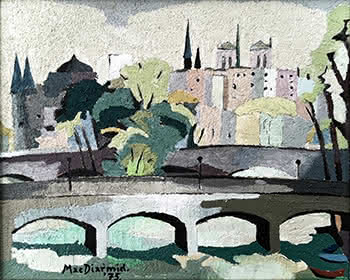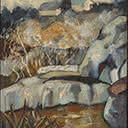Ile de la Cite - Skyline Notre Dame, Conciergerie, Sainte Chapelle
21 x 26 cm
est. $3,000 - 6,000
Douglas MacDiarmid grew up in Taihape and studied for a BA at Canterbury University College in Christchurch, where he began painting. His close friends there included artists Rita Angus, Leo Bensemann, Evelyn Page and Theo Schoon. MacDiarmid travelled to Europe in 1946, returning briefly in 1949, before leaving again to live permanently in France in 1951. He stayed there, principally in Paris, for the rest of his life, though he continued to exhibit his art (41 shows) in New Zealand. In 1961, another friend, Charles Brasch (1909-1973), the founder and editor of the country's foremost arts periodical Landfall, wrote that MacDiarmid is 'an individual being, conscious, proud and unafraid to be himself. I have never met a New Zealander like him'. A biography, Colours of a Life: The Life and Times of Douglas MacDiarmid by Anna Cahill was published in 2018, while Conversations from the Heart (ed. Anna Cahill), a selection of letters between MacDiarmid and the composer Douglas Lilburn, appeared in 2022. There is also a lengthy section on his art and career in Leonard Bell's Strangers Arrive: Emigres and the Visual Arts in New Zealand, 1930-1980 (2017).
MacDiarmid's working career - over seventy years - is one of the longest of any New Zealand artist. He is now recognised as one of the most eminent New Zealand- born artists of his generation. MacDiarmid's art cannot be pigeonholed. He worked in several differing styles simultaneously, from abstract to figurative to abstracted semi-figurative. Living outside New Zealand for most of his life, his subjects were primarily European, Mediterranean and transnational, though he continued to paint some New Zealand topics, mainly landscapes, after his expatriation.
The two paintings on offer exemplify MacDiarmid's principally European foci. His painting is formally accomplished, imaginative and conceptually sophisticated. Overall, his art is characterised by its bold use of colour a 'Continental' expressivity of shape and line, and compositional vibrancy that distinguishes his work from his New Zealand-born peers, who remained in the antipodes. Indeed MacDiarmid's typical high-keyed colour contrasts markedly with the low-keyed colour that predominated in New Zealand art in the early- mid twentieth century. Colourists were rare here then, as MacDiarmid himself and another prominent New Zealand-born expatriate artist, James Boswell (1906- 1971), observed at the time.
These two paintings are good examples of his European landscape painting. The depicted scene in the so-titled Harbour Scene, Dieppe (1956) bears little resemblance to Dieppe harbour, as this writer recalls it, and the painting's last owner thought it represented the harbour at Dover, though that is unlikely too. Rather, it is probably a composite landscape, made of elements from different, including imagined, places. MacDiarmid could do precisely that in his landscapes (his New Zealand ones too). That's an artist's prerogative going back to the seventeenth century at least - to imaginatively reshape bits of the world, rather than simply mimic the topography.
The Ile de la Cite: Skyline Notre Dame, Conciergerie, Saint Chapelle (1975), from Paris, looks somewhat askew topographically too. Could the viewpoint in this painting be found in actuality? Whatever, what MacDiarmid made is a concentrated, dynamic modernist composition, in this instance more subdued colouristically, though nonetheless vibrant in its greens, greys, ochres and whites, plus that forceful black signature and date at the bottom. The earlier youthful harbour scene is a more traditional composition, a symphony (to use James McNeill Whistler's term for his landscape, often involving rivers and coasts, rearrangements) of blues, greys and touches of reddish-browns. Both paintings represent MacDiarmid well - Leonard Bell





